
Interior
“A church you never forget”
Welcome to visit our wonderful church


The Andreas chapel
The church porch, which in Scandinavia is known as the weapons room, where we since old
have laid down our weapons. Here we are at peace. This is a room which protects each and
every one who enters. A bricked bench separates the room.
To our right is the Chapel of S:t Andrew, named after the apostle, the brother of Simon Peter,
who has given his name to our church. Here the altar protruding from the wall.
Sometimes, on sunny days, the sun lays a carpet of light under the altar.
Next to the altar there is a wrought cross called “the Tree of Life” with five wounds in red
glass, which was designed by architect Sigurd Lewerentz and forged by blacksmith Einar
Nilsson in Forsby.

The Christening font
The christening area is located at the church entrance. It is shaped as a rock and
the floor bends upward.
The crack in the floor represents episode when Moses cracked the rock with his
staff making water flow from it.
At the christening, the priest stands in a place on the floor marked with a cross.
The Christening font is made of a white mussel from the Indian Ocean.
The never ending drip re-minds us of God’s never ceasing Grace.



The Altar
At the Holy Communion, the priest stands behind the altar turned towards
the congregation.
The floor slopes slowly down to the altar to help the doubtful towards the
communion table.
Through the chimney-alike lanterns in the ceiling a warm light of heaven
pours into the way of procession from the sacristy to the altar.
The life of a Christian is a daily wandering in the light of God.
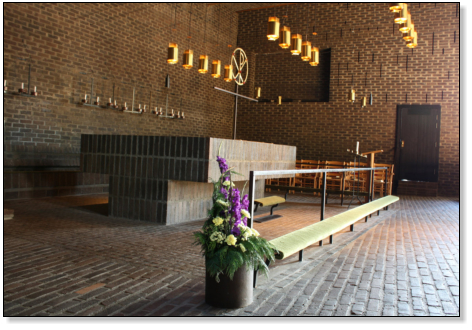
The Cross and the Ring
The cross and the ring standing on the floor beside the altar
is made of wrought iron and designed by artist Robert
Nilsson.
The cross symbolizes Christ's death and resurrection, and
the circle of eternity.
It has a Christ Monogram with five red stones, reminiscent
of Christ's five wounds.
Letters chi (Χ) and rho (Ρ), which are the first two letters of
Greek χριστός "Christ".
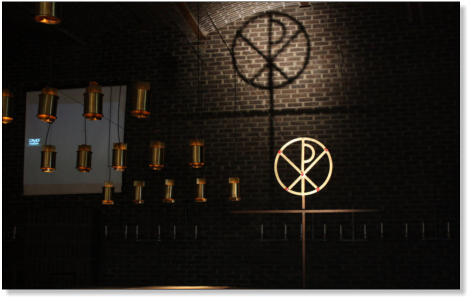
The Pulpit - Bishop chair - Clergy bench
The Pulpit and the altar form a unity. The Church room is built to support
the idea of performing the service according to Luther’s idea about the close
connection between the sermon and the altar service.
The Bishop chair The Cathedra or the Bishop Throne that is placed behind
the altar might be the first of its kind in an evangelical church after the
reformation.
The Clergy bench has a primitive Christian background from the 2nd
century.

The Tapestry
In the church room hangs a mobile tapestry, designed by "X:t", Professor
Sven Erixon and woven by the textile artist Barbro Nilsson. It has two sides,
which the artist describes thus: "The Passion side.
One sees at the top the crown of thorns with the nails, forming a face. The
five drops of blood stand out in red against caput mortuum in the
background. This is shaped like the trunk of a tree.
The other side, the Resurrection, is more radiant in colour, and there one
sees at the very top IHS signifying the triumphant Christ, over a meadow,
imperceptibly fading into a firmament filled with red, black and golden
footprints.
The red and black ones symbolize the hardships of life and the golden ones
are in direct communication with the sign in the sky, IHS."
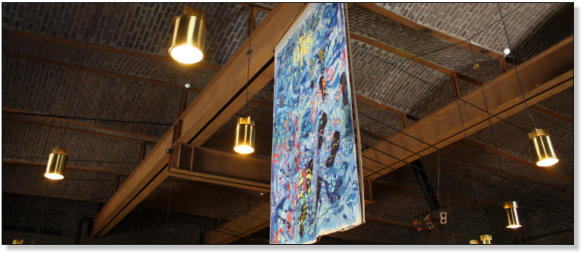
The Organ
The organ, which is placed to the left of the church, built in 1972
by PG Andersen from Copenhagen.
Having the organ was placed on a platform at the back of the
church is often felt unnatural.
In our time there is a desire to place the organ and choir beside the
pulpit.
Choir and organ can naturally participate in the church service.
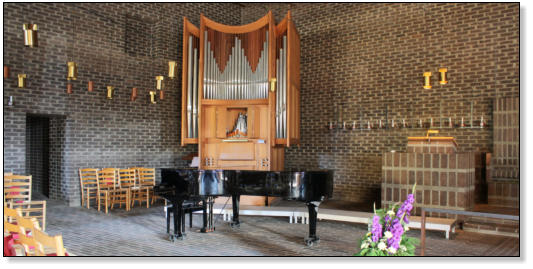
Sacristy
In the belfry is the sacristy with preparatory altar and at its side a
piscina, into which the wine remaining after Holy Communion is
poured out to trickle down into the consecrated earth of the
church.
On the altar is an ivory crucifix, made by the sculptor Christian
Berg.
On the opposite wall of the sacristy hangs a painting of Petrus, a
work of the artist Erik Olsson, a member of the Halmstad Group.


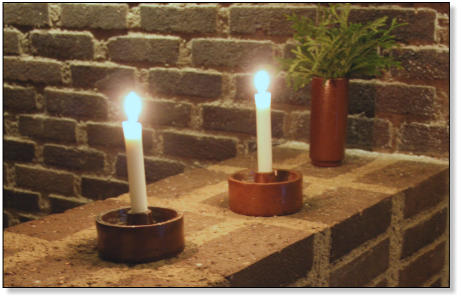

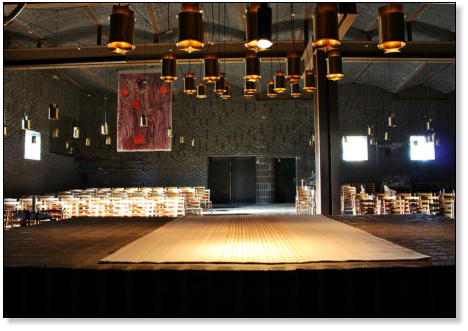

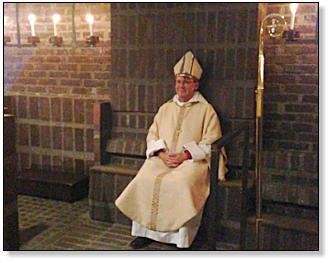





Church Chairs
The loose chairs, in a total of 188 pieces, are arranged in the wide
walled joints, as we see in the floor.
The church chairs were designed in 1930 to Bethlehem Church,
Åboulevard, Copenhagen, the first Danish church to use chairs instead
of benches.
The chairs are braided with seaweeds and are specially designed for
use in churches by the architect Kaare Klint
Inspiration for the chair is a bit of light general furniture like Klints
father, PV Jensen Klint, bought from southern Europe to Grundtvig
church.
Klint develops designed and manufactured the chair more powerful
and comfortable.
The chair is made of beech wood and the legs were swiveled, which
makes mass production easier.
The seat is woven and supported by four strong crosspieces, by being
straight inside and curved on the outside maximal withstand the
tension of the braid.
A few small details to the chair reveal its use characteristics, the little
psalm book the shelf behind the back and the small shelf of lugs for
chassis bags.

© Copyright 2007 - 2023 / Anders Clausson


The Andreas chapel
The church porch, which in Scandinavia is known as
the weapons room, where we since old have laid
down our weapons. Here we are at peace. This is a
room which protects each and every one who enters.
A bricked bench separates the room.
To our right is the Chapel of S:t Andrew, named after
the apostle, the brother of Simon Peter, who has given
his name to our church.
Here the altar protruding from the wall. Sometimes,
on sunny days, the sun lays a carpet of light under the
altar.
Next to the altar there is a wrought cross called “the
Tree of Life” with five wounds in red glass, which
was designed by architect Sigurd Lewerentz and
forged by blacksmith Einar Nilsson in Forsby.

Interior
The Christening font
The christening area is located at the church entrance.
It is shaped as a rock and the floor bends upward.
The crack in the floor represents episode when Moses
cracked the rock with his staff making water flow
from it.
At the christening, the priest stands in a place on the
floor marked with a cross.
The Christening font is made of a white mussel from
the Indian Ocean.
The never ending drip re-minds us of God’s never
ceasing Grace.


The Altar
At the Holy Communion, the priest stands behind the
altar turned towards the congregation.
The floor slopes slowly down to the altar to help the
doubtful towards the communion table.
Through the chimney-alike lanterns in the ceiling a
warm light of heaven pours into the way of procession
from the sacristy to the altar.
The life of a Christian is a daily wandering in the light
of God.
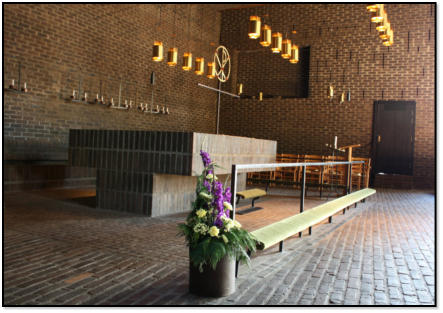


The Pulpit - Bishop chair - Clergy bench
The Pulpit and the altar form a unity. The Church
room is built to support the idea of performing the
service according to Luther’s idea about the close
connection between the sermon and the altar service.
The Bishop chair The Cathedra or the Bishop Throne
that is placed behind the altar might be the first of its
kind in an evangelical church after the reformation.
The Clergy bench has a primitive Christian
background from the 2nd century.
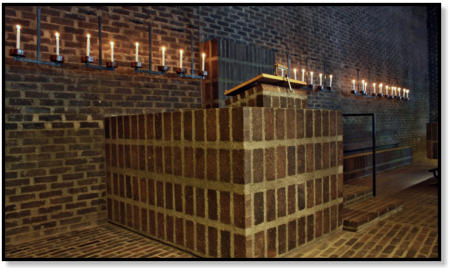



The Cross and the Ring
The cross and the ring standing on the floor beside the
altar is made of wrought iron and designed by artist
Robert Nilsson.
The cross symbolizes Christ's death and resurrection,
and the circle of eternity.
It has a Christ Monogram with five red stones,
reminiscent of Christ's five wounds.
Christ monogram composed of the Greek letters X
(Chi / K) and R (Rho / R) which is the first two letters
of the name Christos = Christ.



The Tapestry
In the church room hangs a
mobile tapestry, designed by
"X:t", Professor Sven Erixon
and woven by the textile
artist Barbro Nilsson. It has
two sides, which the artist
describes thus: "The Passion
side.
One sees at the top the crown
of thorns with the nails,
forming a face. The five
drops of blood stand out in
red against caput mortuum in
the background. This is
shaped like the trunk of a
tree.
The other side, the Resurrection, is more radiant in
colour, and there one sees at the very top IHS
signifying the triumphant Christ, over a meadow,
imperceptibly fading into a firmament filled with red,
black and golden footprints.
The red and black ones symbolize the hardships of
life and the golden ones are in direct communication
with the sign in the sky, IHS."



The Organ
The organ, which is placed to the left of the church,
built in 1972 by PG Andersen from Copenhagen.
Having the organ was placed on a platform at the back
of the church is often felt unnatural. In our time there
is a desire to place the organ and choir beside the
pulpit.
Choir and organ can naturally participate in the church
service.



Sacristy
In the belfry is the sacristy with preparatory altar and
at its side a piscina, into which the wine remaining
after Holy Communion is poured out to trickle down
into the consecrated earth of the church.
On the altar is an ivory crucifix, made by the sculptor
Christian Berg.
On the opposite wall of the sacristy hangs a painting
of Petrus, a work of the artist Erik Olsson, a member
of the Halmstad Group.
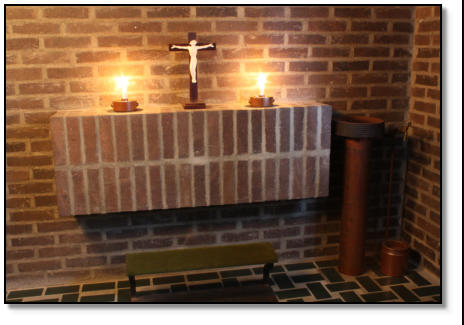




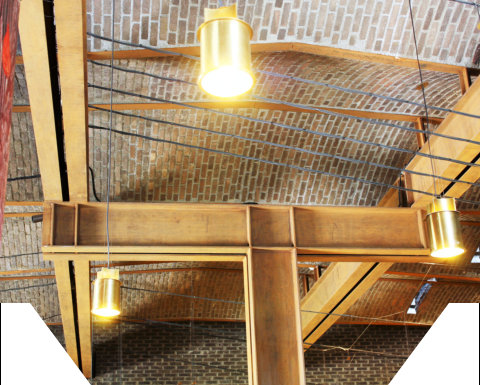



Sankt Petri Church
in Klippan
© Copyright 2007 - 2023 / Anders Clausson
A church you never forget
Welcome to visit our wonderful church
Masterpiece by Sigurd Lewerentz

























